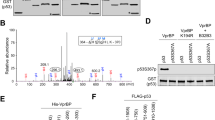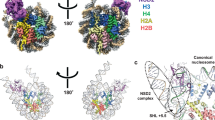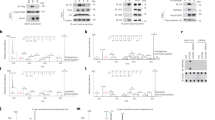Abstract
Histone Arg methylation and Lys acetylation have been found to cooperatively regulate the expression of p53-target genes. Peptidylarginine deiminase 4 (PAD4) is an enzyme that citrullinates histone arginine and monomethyl-arginine residues thereby regulating histone Arg methylation. We have recently found that PAD4 serves as a p53 corepressor to regulate histone Arg methylation at the p53-target gene p21/WAF1/CIP1 promoter. However, it has not been tested whether histone Arg citrullination coordinates with other histone modifications to repress transcription. Here, we show that histone deacetylase (HDAC2) and PAD4 interact with p53 through distinct domains and simultaneously associate with the p21 promoter to regulate gene expression. After DNA damage, PAD4 and HDAC2 dissociate from several p53-target gene promoters (for example, p21, GADD45, and PUMA) with a concomitant increase in histone Lys acetylation and Arg methylation at these promoters. Furthermore, PAD4 promoter association and histone Arg modifications are regulated by p53 and HDAC activity. In contrast, HDAC2 promoter association and histone Lys acetylation are affected by p53 and PAD4 activity at minor degrees. Importantly, PAD4 inhibitor Cl-amidine and HDAC inhibitor suberoylanilide hydroxamic acid show additive effects in inducing p21, GADD45, and PUMA expression and inhibiting cancer cell growth in a p53-dependent manner. Our results unveil an important crosstalk between histone deacetylation and citrullination, suggesting that a combination of PAD4 and HDAC2 inhibitors as a potential strategy for cancer treatment.
This is a preview of subscription content, access via your institution
Access options
Subscribe to this journal
Receive 50 print issues and online access
$259.00 per year
only $5.18 per issue
Buy this article
- Purchase on Springer Link
- Instant access to full article PDF
Prices may be subject to local taxes which are calculated during checkout





Similar content being viewed by others
References
An W, Kim J, Roeder RG . (2004). Ordered cooperative functions of PRMT1, p300, and CARM1 in transcriptional activation by p53. Cell 117: 735–748.
Arita K, Hashimoto H, Shimizu T, Nakashima K, Yamada M, Sato M . (2004). Structural basis for Ca(2+)-induced activation of human PAD4. Nat Struct Mol Biol 11: 777–783.
Baek HJ, Malik S, Qin J, Roeder RG . (2002). Requirement of TRAP/mediator for both activator-independent and activator-dependent transcription in conjunction with TFIID-associated TAF(II)s. Mol Cell Biol 22: 2842–2852.
Barlev NA, Liu L, Chehab NH, Mansfield K, Harris KG, Halazonetis TD et al. (2001). Acetylation of p53 activates transcription through recruitment of coactivators/histone acetyltransferases. Mol Cell 8: 1243–1254.
Barski A, Cuddapah S, Cui K, Roh TY, Schones DE, Wang Z et al. (2007). High-resolution profiling of histone methylations in the human genome. Cell 129: 823–837.
Bedford MT, Clarke SG . (2009). Protein arginine methylation in mammals: who, what, and why. Mol Cell 33: 1–13.
Berger SL . (2007). The complex language of chromatin regulation during transcription. Nature 447: 407–412.
Causey CP, Thompson PR . (2008). An improved synthesis of haloaceteamidine-based inactivators of protein arginine deiminase 4 (PAD4). Tetrahedron Lett 7: 4383–4385.
Chang X, Han J . (2006). Expression of peptidylarginine deiminase type 4 (PAD4) in various tumors. Mol Carcinog 45: 183–196.
Chang X, Han J, Pang L, Zhao Y, Yang Y, Shen Z . (2009). Increased PADI4 expression in blood and tissues of patients with malignant tumors. BMC Cancer 9: 40.
Cuthbert GL, Daujat S, Snowden AW, Erdjument-Bromage H, Hagiwara T, Yamada M et al. (2004). Histone deimination antagonizes arginine methylation. Cell 118: 545–553.
Dannenberg JH, David G, Zhong S, van der Torre J, Wong WH, Depinho RA . (2005). mSin3A corepressor regulates diverse transcriptional networks governing normal and neoplastic growth and survival. Genes Dev 19: 1581–1595.
Espinosa JM, Emerson BM . (2001). Transcriptional regulation by p53 through intrinsic DNA/chromatin binding and site-directed cofactor recruitment. Mol Cell 8: 57–69.
Fischle W, Wang Y, Allis CD . (2003). Histone and chromatin cross-talk. Curr Opin Cell Biol 15: 172–183.
Gui CY, Ngo L, Xu WS, Richon VM, Marks PA . (2004). Histone deacetylase (HDAC) inhibitor activation of p21WAF1 involves changes in promoter-associated proteins, including HDAC1. Proc Natl Acad Sci USA 101: 1241–1246.
Harms KL, Chen X . (2007). Histone deacetylase 2 modulates p53 transcriptional activities through regulation of p53-DNA binding activity. Cancer Res 67: 3145–3152.
Harris SL, Levine AJ . (2005). The p53 pathway: positive and negative feedback loops. Oncogene 24: 2899–2908.
Ho J, Benchimol S . (2003). Transcriptional repression mediated by the p53 tumour suppressor. Cell Death Differ 10: 404–408.
Jenuwein T, Allis CD . (2001). Translating the histone code. Science 293: 1074–1080.
Kitayner M, Rozenberg H, Kessler N, Rabinovich D, Shaulov L, Haran TE et al. (2006). Structural basis of DNA recognition by p53 tetramers. Mol Cell 22: 741–753.
Klose RJ, Zhang Y . (2007). Regulation of histone methylation by demethylimination and demethylation. Nat Rev Mol Cell Biol 8: 307–318.
Kornberg RD, Lorch Y . (1999). Twenty-five years of the nucleosome, fundamental particle of the eukaryote chromosome. Cell 98: 285–294.
Kouzarides T . (2007). Chromatin modifications and their function. Cell 128: 693–705.
Laptenko O, Prives C . (2006). Transcriptional regulation by p53: one protein, many possibilities. Cell Death Differ 13: 951–961.
Levesque AA, Eastman A . (2007). p53-based cancer therapies: Is defective p53 the Achilles heel of the tumor? Carcinogenesis 28: 13–20.
Li B, Carey M, Workman JL . (2007). The role of chromatin during transcription. Cell 128: 707–719.
Li P, Yao H, Zhang Z, Li M, Luo Y, Thompson PR et al. (2008). Regulation of p53 target gene expression by peptidylarginine deiminase 4. Mol Cell Biol 28: 4745–4758.
Luger K, Mader AW, Richmond RK, Sargent DF, Richmond TJ . (1997). Crystal structure of the nucleosome core particle at 2.8 A resolution. Nature 389: 251–260.
Luo J, Su F, Chen D, Shiloh A, Gu W . (2000). Deacetylation of p53 modulates its effect on cell growth and apoptosis. Nature 408: 377–381.
Marks PA, Breslow R . (2007). Dimethyl sulfoxide to vorinostat: development of this histone deacetylase inhibitor as an anticancer drug. Nat Biotechnol 25: 84–90.
Minucci S, Pelicci PG . (2006). Histone deacetylase inhibitors and the promise of epigenetic (and more) treatments for cancer. Nat Rev Cancer 6: 38–51.
Shi Y, Downes M, Xie W, Kao HY, Ordentlich P, Tsai CC et al. (2001). Sharp, an inducible cofactor that integrates nuclear receptor repression and activation. Genes Dev 15: 1140–1151.
Shilatifard A . (2006). Chromatin modifications by methylation and ubiquitination: implications in the regulation of gene expression. Annu Rev Biochem 75: 243–269.
Strahl BD, Allis CD . (2000). The language of covalent histone modifications. Nature 403: 41–45.
Turner BM . (2000). Histone acetylation and an epigenetic code. Bioessays 22: 836–845.
Vogelstein B, Lane D, Levine AJ . (2000). Surfing the p53 network. Nature 408: 307–310.
Wang Y, Wysocka J, Sayegh J, Lee YH, Perlin JR, Leonelli L et al. (2004). Human PAD4 regulates histone arginine methylation levels via demethylimination. Science 306: 279–283.
Yao H, Li P, Venters BJ, Zheng S, Thompson PR, Pugh BF et al. (2008). Histone Arg modifications and p53 regulate the expression of OKL38, a mediator of apoptosis. J Biol Chem 283: 20060–20068.
Acknowledgements
We are grateful to Drs JC Reese, DS Gilmour, BF Pugh, and S Tan for discussions and helpful comments. Research is supported in part by a PSU start-up fund and NIH Grants R01 CA136856 to YW (PSU) and R01 CA116522 to YW (UC Riverside).
Author information
Authors and Affiliations
Corresponding author
Ethics declarations
Competing interests
The authors declare no conflict of interest.
Additional information
Supplementary Information accompanies the paper on the Oncogene website
Supplementary information
Rights and permissions
About this article
Cite this article
Li, P., Wang, D., Yao, H. et al. Coordination of PAD4 and HDAC2 in the regulation of p53-target gene expression. Oncogene 29, 3153–3162 (2010). https://doi.org/10.1038/onc.2010.51
Received:
Revised:
Accepted:
Published:
Issue Date:
DOI: https://doi.org/10.1038/onc.2010.51
Keywords
This article is cited by
-
Role of Peptidylarginine Deiminase 4 in Central Nervous System Diseases
Molecular Neurobiology (2023)
-
Histone citrullination: a new target for tumors
Molecular Cancer (2021)
-
Down-regulation of PADI2 prevents proliferation and epithelial-mesenchymal transition in ovarian cancer through inhibiting JAK2/STAT3 pathway in vitro and in vivo, alone or in combination with Olaparib
Journal of Translational Medicine (2020)
-
Inhibiting PAD2 enhances the anti-tumor effect of docetaxel in tamoxifen-resistant breast cancer cells
Journal of Experimental & Clinical Cancer Research (2019)
-
Probing the Roles of Calcium-Binding Sites during the Folding of Human Peptidylarginine Deiminase 4
Scientific Reports (2017)



